#massimo banzi arduino
Text
TEDにて
マッシモ・バンジ:創造力をオープンソース化するArdurino
(詳しくご覧になりたい場合は上記リンクからどうぞ)
マッシモ・バンジが生みの親の一人であるArduino(アルデゥイーノ)は、小さな使いやすいオープンソースのマイクロコントローラーで世界の何千という人たちを触発しおもちゃから人工衛星まで創造力の限りを尽くした素敵な物の数々を作らせることになりました。
彼が言うように、「何かすごいものを作るのに誰の許可もいらない」のです(オープンソースは世界の教育格差を解消する目的の一環)
Arduinoの何がいいかというと、このハードウェアが・・・愛を込めてイタリアで作られたこと。これは基盤の裏を見てもらえば 分かりますが、それに加えてオープンであるということ。回路の設計書は、すべてネットで公開されていてそれをダウンロードして何かを作ったり改良したり学ぶために使えます。
プログラミングを学んでいた頃。他の人のコードや 雑誌に載っていた回路図を見て勉強していました。このプロジェクトの様々なものがオープンにされています。ハードウェアは、クリエイティブコモンズライセンスで公開されています。
ハードウェアが歌や詩のように一部として、クリエイティブ・コモンズで共有され、それを元に新しいものを作っていけるという考えは素敵だと思います。また、ソフトウェアは、GPLでこれもオープンソースです。ドキュメントや実践的なトレーニング方法もクリエイティブコモンズで公開されたオープンソースです。
Arduino自体。多くのオープンソースの要素から成り立っています。それぞれの要素は、12歳の子が使うには難しいものですが、それをArduinoでマッシュアップして1つにまとめ上げ、手早くものを作り上げられる最高のユーザー体験を与えられるよう努めています。
Arduinoは、また大型ハドロン衝突型加速器のような本格的な現場でも使われています。アートプロジェクトもあります。この機械は、DIYバイオ・ムーブメントから生まれたもので、DNA処理に必要なあるステップを行います。これもすべてオープンソースになっています。
Googleのような会社もこのテクノロジーを使って、携帯電話やタブレットと現実世界の間のインターフェースを作っています。GoogleのADKは、Arduinoベースのオープンソースです。
しかし、こんなに沢山のアイデアがあるときいったいどうしたものでしょう?何千というアイデアがあって全部紹介しようと思ったら7時間もかかるでしょう。7時間やるつもりはありませんので、ただ、この例だけご覧いただきましょう。
この人たちは、Pebbleという会社を作ってブルートゥースで携帯と連携して情報を表示する腕時計を試作しました。ノキアの携帯から取った液晶画面とArduinoを使っています。それから商品化のための資金10万ドルをKickstarterで募りました。そうしたら、1千万ドル集まったんです。十分な資金が得られただ素晴らしい製品で人々を熱狂させたんです。
最後にご紹介したいプロジェクトは、ArduSatです。Kickstarterで募集中(現在終了)なので、貢献したい方はどうぞ。宇宙に飛ばす衛星です。オープンソースでやろうとは、なかなか思わないことですが、Arduinoを沢山のセンサーに繋いでいます。
ですから、Arduinoの使い方を知っていれば、自分の実験をこの衛星にアップロードして実施できるんです。想像してみてください。自分で1週間衛星を自由に使えて宇宙で実験するというのを!
言いました通り例はあまりに沢山あるのでこの辺でお終いにしておきましょう。毎日、たくさんのすごいプロジェクトを生み出し続けているArduinoコミュニティに感謝したいと思います。ありがとうございました。
MakerBotの3Dプリンターの頭脳にも使用されていますし、クワッドコプターにも使用されている物もあります。こちらはイタリア製ですがRaspberry Pi(ラズベリーパイ)という選択肢もあります。
これは、ラズベリーパイ財団によってイギリスで開発されたARMプロセッサを搭載したシングルボードコンピューターで、10年前のパソコンの処理能力(ほぼ700MHz)が搭載されています。
たった数千円で電子工作以上のPICプログラムが組めるなんて•••
しかも、会社でしかできなかったことが、簡単にできるなんて、素晴らしい世の中になったもんですね。
2015年には、Raspberry Pi 2も登場し、CPUは「ARM Cortex-A7」(4コア・900MHz)に処理能力を上げて、メモリは1GBに増加しました。
さらに、7インチタッチスクリーンも登場。このタッチスクリーンでは、簡単な設定だけでベーシックで持ち運べるタブレットやノートパソコンを構築できるようになります。
2017年時点では、Raspberry Pi 3にバージョンアップしています。
2023年には、Raspberry Pi 5にバージョンアップ。SoCにBroadcom BCM2712(4コア/2.4GHz、Arm Cortex-A76)を搭載。前世代のRaspberry Pi 4と比べてCPU性能が2倍以上高速化した。
GPUがVideoCore VIIで性能が向上。メモリは4GBまたは8GB LPDDR4X-4267。
I/Oコントローラには独自開発のRP1を採用し、各種インターフェイス機能が改善、PCI Express 2.0が新たに利用可能になりました。
グラフィックボードの接続も可能かもしれないので、ChatGPTなどの大規模言語プログラムをスタンドアローンで動かせるかもしれません。
しかし、Arduino(アルデゥイーノ)もリアルタイム性やアナログ処理の性能の良さがあります。
情報技術の発展とインターネットで大企業の何十万、何百万単位から、facebook、Apple、Amazom、Google、Microsoftなどで数億単位で共同作業ができるようになりました。
現在、プラットフォーマー企業と呼ばれる法人は先進国の国家単位レベルに近づき欧米、日本、アジア、インドが協調すれば、中国の人口をも超越するかもしれません。
法人は潰れることを前提にした有限責任! 慈愛や基本的人権を根本とした社会システムの中の保護されなければならない小企業や個人レベルでは、違いますが・・・
ヨーロッパでの一般データ保護規則(GDPR)でも言うように・・・
年収の低い個人(中央値で600万円以下)から集めたデータほど金銭同様に経済的に高い価値を持ち、独占禁止法の適用対象にしていくことで、高価格にし抑止力を持たせるアイデア。
自分自身のデータを渡す個人も各社の取引先に当たりデータに関しては優越的地位の乱用を年収の低い個人(中央値で600万円以下)に行う場合は厳しく適用していく。
なお、ビックデータは教育や医療に限定してなら、多少は有効かもしれません。それ以外は、日本の場合、プライバシーの侵害です。
通信の秘匿性とプライバシーの侵害対策として、匿名化処理の強化と強力な暗号化は絶対必要です!
さらに、オープンデータは、特定のデータが、一切の著作権、特許などの制御メカニズムの制限なしで、全ての人が
望むように再利用・再配布できるような形で、商用・非商用問わず、二次利用の形で入手できるべきであるというもの。
主な種類では、地図、遺伝子、さまざまな化合物、数学の数式や自然科学の数式、医療のデータやバイオテクノロジー
サイエンスや生物などのテキスト以外の素材が考えられます。
こういう新産業でイノベーションが起きるとゲーム理論でいうところのプラスサムになるから既存の産業との
戦争に発展しないため共存関係を構築できるメリットがあります。デフレスパイラルも予防できる?人間の限界を超えてることが前提だけど
しかし、独占禁止法を軽視してるわけではありませんので、既存産業の戦争を避けるため新産業だけの限定で限界を超えてください!
最後に、マクロ経済学の大目標には、「長期的に生活水準を高め、今日のこども達がおじいさん達よりも良い暮らしを送れるようにする!!」という目標があります。
経済成長を「パーセント」という指数関数的な指標で数値化します。経験則的に毎年、経済成長2%くらいで巡航速度にて上昇すれば良いことがわかっています。
たった、経済成長2%のように見えますが、毎年、積み重ねるとムーアの法則みたいに膨大な量になって行きます。
また、経済学は、大前提としてある個人、法人モデルを扱う。それは、身勝手で自己中心的な欲望を満たしていく人間の部類としては最低クズというハードルの高い個人、法人。
たとえば、生産性、利益という欲だけを追求する人間。地球を救うという欲だけを追求する人間。利益と真逆なぐうたらしたい時間を最大化したいという欲を追求する人間。などの最低生活を保護、向上しつつお金の循環を通じて個人同士の相互作用も考えていく(また、憎しみの連鎖も解消する)
多様性はあるが、欲という側面では皆平等。つまり、利益以外からも解決策を見出しお金儲けだけの話だけではないのが経済学(カントの「永遠平和のために」思想も含めて国家や権力者は透明性を究極にして個人のプライバシーも考慮)
(個人的なアイデア)
こういうロケットエンジン、ジェット機くらいのひとつ数億円単位で手の届かない価格帯の商品を庶民に手の届く数十万円くらいの価格帯に人間の限界を遥かに超えるテクノロジーで実現することが本当のプラスサムになるイノベーションかもしれません。
<おすすめサイト>
ティム・バーナーズ=リー:ウェブのための大憲章(マグナカルタ)
MicroView: Chip-sized Arduino with built-in OLED Display!
MicroLink GSM - tiny, Arduino compatible, rapid prototyping
Dobot: Robotic Arm for Everyone! Arduino & Open Source
Hackabot Nano: Compact Plug and Play Arduino Robot
ルネデカルトの「方法序説」についてOf Rene Descartes on “Discourse on Method”
デイヴィッド・ブルックス:人間の本質と社会的動物
デール・ドーファティ:私たちはメーカーMakerである!
<提供>
東京都北区神谷の高橋クリーニングプレゼント
独自サービス展開中!服の高橋クリーニング店は職人による手仕上げ。お手頃50ですよ。往復送料、曲Song購入可。詳細は、今すぐ電話。東京都内限定。北部、東部、渋谷区周囲。地元周辺区もOKです
東京都北区神谷高橋クリーニング店Facebook版
#マッシモ#バンジ#Arduino#アルデゥイーノ#オープン#ソース#人工#衛星#3D#Printer#プリンター#Raspberry#Pi#PIC#fab#english#england#ラズベリー#パイ#プログラム#ヒーリング#NHK#zero#ニュース#発見#discover#discovery
0 notes
Text
Arduino nedir ve nasıl çalışır?Arduino, bir mikrodenetleyici platformudur ve elektronik projeler geliştirmek için kullanılır. Adını İtalyan bir otomasyon firması olan Arduino SRL den almıştır. Arduino, kullanıcıların çeşitli elektronik bileşenleri ve sensörleri kontrol etmelerini sağlar. Temel olarak, bir mikrodenetleyici birimine (MCU) sahip olan bir açık kaynak donanım ve yazılım platformudur.Arduino, çeşitli giriş/çıkış (I/O) pinlerine ve bir USB bağlantısına sahiptir. Bu özellikleri sayesinde, sensörler, motorlar, ışıklar ve diğer bileşenlerle etkileşime geçebilir. Arduino ile programlama yapabilmek için Arduino Yazılım Geliştirme Ortamı (IDE) kullanılır. Bu platform, kullanıcıların Python ve C ++ gibi dillerle etkileşime girmesine olanak tanır.Arduino, genellikle gömülü sistem projeleri için tercih edilen bir platformdur. Çünkü kullanımı kolaydır ve geniş bir kullanıcı topluluğuna sahiptir. Arduino'nun, elektronik projelerdeki esnekliği ve özelleştirilebilirliği, geliştiricilerin dikkatini çeken diğer özellikler arasındadır.İlk prototip, İtalyan Ar-Ge uzmanları Massimo Banzi, David Cuartielles, Tom Igoe ve David Mellis tarafından 2005 yılında tasarlandı. O günden bu yana, Arduino platformu sürekli olarak geliştirilmiş ve dünya çapında milyonlarca kullanıcı tarafından benimsenmiştir.Arduino'nun temel bileşenleri nelerdir?
Arduino'nun temel bileşenleri, devre kartı, mikrodenetleyici (genellikle ATMega), dijital ve analog giriş/çıkış pinleri (GPIO), güç jakı, LED'ler, reset düğmesi, USB bağlantı noktası ve ICSP (In-Circuit Serial Programming) başlık noktaları gibi unsurlardan oluşur.
Bu bileşenler arasında Arduino'nun kalbi olarak adlandırılan mikrodenetleyici oldukça önemlidir. Mikrodenetleyici, tüm işlemlerin gerçekleştiği beyin olarak düşünülebilir. Bunun yanı sıra, devre kartı üzerinde bulunan dijital ve analog pinler, elektronik projelerde sensörler ve modüllerin bağlanmasını sağlar.
Ayrıca, Arduino'nun USB bağlantı noktası sayesinde bilgisayarla bağlantı kurulabilir ve program yüklenebilir. Reset düğmesi, devre kartının yeniden başlatılmasını sağlar ve ICSP başlık noktaları sayesinde farklı programlama yöntemleri kullanılabilir.
Tüm bu bileşenler, Arduino'nun temel yapı taşlarını oluşturur ve elektronik projelerin gerçekleştirilmesinde büyük öneme sahiptir.
Arduino kullanmanın avantajları nelerdir?
Arduino, elektronik projelerinizi gerçekleştirebileceğiniz oldukça kullanışlı bir platformdur. Bu cihazın kullanımının pek çok avantajı bulunmaktadır. Birinci avantajı, Arduino platformunun geniş bir kullanıcı kitlesine sahip olmasıdır. Bu, projelerinizle ilgili sorun yaşadığınızda veya yardıma ihtiyacınız olduğunda topluluk desteği alabileceğiniz anlamına gelir.
Bununla birlikte, Arduino kullanmanın bir diğer avantajı da düşük maliyetlidir. Birçok elektronik platformun aksine, Arduino donanımı oldukça ucuz ve erişilebilirdir. Bu da öğrenme ve deneme yapma konusunda daha fazla özgürlük sağlar.
Ayrıca, Arduino platformunun tasarımı oldukça esnektir. Bu, kullanıcıların kendi projelerini oluştururken istedikleri bileşenleri kolayca ekleyip çıkarmalarını sağlar. Bu da projelerinizin daha özgün ve özgün olmasını sağlar.
Son olarak, Arduino öğrenme süreci oldukça basittir. Kullanıcılar, programlama ve elektronik konusunda daha önce deneyimi olmasa bile, Arduino ile hızla öğrenebilir ve kendi projelerini hayata geçirebilirler.Arduino projeleri nasıl gerçekleştirilir?
Arduino projeleri gerçekleştirmek için öncelikle bir fikir belirlemek çok önemlidir. Hangi konuda bir proje gerçekleştirmek istediğinize karar vermek, projenin ne tür bir donanım ve yazılım gerektireceğini belirlemenize yardımcı olacaktır. Örneğin, evde hava durumu istasyonu oluşturmak, bir robot yapmak veya akıllı bir sulama sistemi inşa etmek gibi çeşitli projeler için farklı bileşenler ve kodlar gerekecektir.
Projeyi gerçekleştirmek için gerekli olan Arduino kartını seçmek de çok önemlidir. Proje için uygun olan Arduino modelini seçmek, projenin başarılı bir şekilde tamamlanmasına yardımcı olacaktır.
Ayrıca, projenin gereksinim duyduğu bileşenleri (sensörler, motorlar, LED'ler vb.) belirlemek ve bunları temin etmek de projenin gerçekleştirilmesi için önemlidir.
Ardından, gerekli donanımları toplamak ve devreyi kurmak gerekecektir. Proje için gerekli olan devreleri oluşturmak ve bileşenleri devreye bağlamak, projenin fiziksel olarak gerçekleştirilmesi için önemlidir. Devrelerin ve bileşenlerin doğru bir şekilde bağlanması, projenin istenilen şekilde çalışmasını sağlayacaktır.
Son olarak, projenin yazılım kısmını tamamlamak ve Arduino kartına yüklemek gerekecektir. Projenin çalışması için gerekli olan kodları yazmak ve kart üzerine yüklemek, projenin tamamlanması için son adımdır. Yazılımın doğru bir şekilde çalışması, projenin istenilen fonksiyonları yerine getirmesini sağlayacaktır.
Arduino ile hangi tür projeler yapılabilir?Arduino, geniş kullanım alanı sayesinde birçok farklı türde projenin geliştirilmesine imkan sağlar. Özellikle elektronik, robotik, IoT (nesnelerin interneti), otomasyon ve uzaktan kumandalı sistemler gibi alanlarda birçok farklı proje Arduino ile gerçekleştirilebilir.Arduino, sensörler, motorlar, LED'ler, LCD ekranlar, bluetooth modülleri gibi birçok bileşeni kontrol etme yeteneğine sahip olduğu için hava durumu istasyonları, akıllı ev sistemleri, robot kol uygulamaları, otonom araçlar gibi karmaşık projelerin yanı sıra sıcaklık kontrol üniteleri, akıllı sulama sistemleri, engel algılayıcılar gibi basit projeler de geliştirilebilir.Arduino ayrıca çeşitli çevresel koşullara uyum sağlayabilen ve enerji verimliliği sağlayan projelerin de geliştirilmesini destekler. Bununla beraber, Arduino'nun düşük maliyeti ve geniş kütüphanesi sayesinde, kullanıcılar tarafından hayal edilen birçok farklı projenin gerçekleştirilebilmesine olanak tanır.Ayrıca, Arduino'nun modüler yapısı ve açık kaynak kodlu olması, kullanıcıların mevcut projeleri kolayca özelleştirmesine ve farklı projelerle entegre etmesine imkan sağlar. Bu nedenle, Arduino ile sadece sınırlı sayıda türde proje yapılmaz, aksine kullanıcıların hayal gücüne ve ihtiyacına göre birçok farklı türde proje geliştirilebilir.Arduino'da kullanılan programlama dili nedir?Arduino'da kullanılan programlama dili, Arduino programlama ve geliştirme ortamında bulunan C++ dilidir. C++, Arduino platformunda kullanıcıların mikrodenetleyici kartlarını programlamak ve kontrol etmek için kullanılan bir dildir. Arduino ortamının sunduğu kütüphaneler ve işlevler, C++ dilinin avantajlarından yararlanarak Arduino kartlarının kolayca programlanmasını sağlar. Arduino programlama dili olarak C++ kullanmanın bir diğer avantajı ise dünya genelinde geniş bir kullanıcı kitlesine sahip olmasıdır. Bu durum, Arduino kullanıcıları için kaynak bulmayı ve sorunları çözmeyi kolaylaştırır. Ayrıca, C++ dilini öğrenmek, kullanıcıların genel programlama becerilerini geliştirmelerine de yardımcı olur. Arduino kartlarının programlanması için C++ dilinin kullanılması, kullanıcıların daha karmaşık ve profesyonel projeler geliştirmelerine olanak tanır. C++ dilinin esnekliği sayesinde, Arduino ile farklı sensörler, motorlar ve diğer bileşenlerin entegrasyonu kolaylıkla yapılabilir. Sonuç olarak, Arduino'da kullanılan programlama dili olan C++, kullanıcılarına geniş kaynak ve destek ağının yanı sıra profesyonel ve karmaşık projeler geliştirmelerine olanak sağlayan bir dil olarak öne çıkmaktadır.
0 notes
Video
vimeo
Qu’est ce qui empêche les professionnels de la cybersécurité de dormir ? from ITRtv on Vimeo.
Les actionnaires salariés de la Redoute, désormais pure player de l’e-commerce, se partagent près de 100 M€ suite au rachat de l’entreprise par le groupe Galeries Lafayette, via sa holding Motier.
TomTom, spécialiste des technologies de géolocalisation, publie la 12e édition de son Traffic Index annuel, qui dresse un bilan des tendances en matière de circulation dans 389 villes de 56 pays pour l’année 2022. Le coût de la conduite a atteint de nouveaux sommets à travers le monde Le coût des déplacements a explosé en 2022. Londres (centre) est la ville où la vitesse moyenne a été la plus lente en 2022 : 25 km/h (14 km/h aux heures de pointe). En 2022, le coût moyen de déplacement en France a augmenté de 14% pour un véhicule essence et 25% pour une voiture diesel par rapport à 2021
Qu’est ce qui empêche les professionnels de la cybersécurité de dormir ? Dans sa dernière étude, Palo Alto Networks révèle que 57% des professionnels de la cybersécurité déclarent avoir subi trois attaques voire plus au cours des 12 derniers mois ; en France, ils sont 79% à le confirmer.
Les 3 principaux challenges de cybersécurité A l’échelle mondiale, les personnes interrogées : la complexité de la gestion du périmètre des données, le manque de professionnels qualifiés et l’inadéquation entre l’évolution des technologies et celle de la sécurité.
Claire Vallaeys, Ingénieur Pédagogique chez AssessFirst ; fait un point sur les emplois en CDI qui concernait 72 % de la population active en 1975 et seulement 59 % et en 2022. Cependant, Claire Vallaeys constate une démocratisation d'autres formes de travail, permettant d'imaginer et d'inventer de nouveaux possibles comme le Freelancing qui permet par exemple de ne plus cumuler des postes, mais des missions.
Le livre « Démarrez avec Arduino », écrit par Massimo Banzi et Michael Shiloh, présente le composant et les bases en électronique et en programmation nécessaires à sa mise en œuvre immédiate d’Arduino. Différents exemples de difficulté croissante permettent d’appréhender progressivement tout le potentiel pour ensuite donner libre cours à son imagination. Cette 4e édition, intégralement revue, contient des nouveaux chapitres sur le cloud, la gamme ARM et un exemple pas-à-pas complet de "check" connecté.
N’hésitez pas à regarder la vidéo pour connaître l’intégralité des propos ou à vous connecter sur le site itrtv.com
0 notes
Photo

MATRICE LAVORO
Exhibition at Base Milano
Intervengono: Andrea Biffi (Coclea), Giorgio Bigatti (Fondazione ISEC), René Capovin (musil Brescia), Andrea Pedrali (Comune di Cedegolo)
Con: Massimo Banzi (Arduino), Sara Zanisi, Giulia Bertolazzi
E le artiste Maddalena Fragnito e Francesca Marconi
La mostra è visitabile gratuitamente in Ground Hall a BASE dal 3 all’11 dicembre.
In occasione della presentazione del 3 dicembre “Raccontare Matrice Lavoro”,
Maddalena Fragnito e Valeria Graziano condividono due “work in progress”.
RADIO GABINETTO - studio #1, già presentato in occasione del Festival FAROUT 2022, un’installazione sonora che rievoca la contraffattura, la tecnica di mutare i testi delle canzoni lasciandone inalterate le melodie all’origine di numerosi canti di lotta operai. BATTERE LE CIGLIA A COMANDO, il processo di stesura di un libro a venire che indaga l’intreccio fra salute e tecnologie nei luoghi del lavoro, a partire dal materiale di archivio messo a disposizione dall’Archivio ISEC e dalle interviste fatte a un gruppo eterogeneo di gig workers nei mesi di residenza.
RADIO GABINETTO
Tra il 1960 e 1970, in Italia, le lavoratrici della fabbrica tessile del marchio Lebole si incontrano nei gabinetti dello stabilimento per condividere problemi, organizzare assemblee e scioperi e contraffare melodie pop da cantare alla catena di montaggio e ai cortei. Questo spazio-tempo di cospirazione è da loro
soprannominato “Radio Gabinetto”. Radio Gabinetto è una installazione sonora che intreccia le storie delle lotte delle operaie della fabbrica tessile Lebole a cavallo degli anni ‘70 con le esperienze di lavoratori e lavoratrici del contemporaneo. Grazie al recupero di materiale d’archivio della Fondazione ISEC e alle interviste fatte a un gruppo eterogeneo di gig workers, l’installazione annoda le istanze che emergono negli anni in cui si intensifica la cosiddetta “organizzazione scientifica del lavoro” con le attuali condizioni lavorative su tecnologia algoritmica. Un’indagine sulla tossicità al e del lavoro, tra logoramento fisico ed emotivo, tra corpo e tecnologie di produzione.
BATTERE LE CIGLIA A COMANDO
Dalla fabbrica Lebole alla piattaforma Onlyfans Battere le ciglia a comando è il titolo di un’inchiesta del 1969 sui ritmi di lavoro massacranti che si registrano nelle fabbriche italiane a seguito dell’introduzione del metodo americano MTM (Misura dei Tempi e dei Metodi). L’inchiesta è firmata Luigi Ferraro e pubblicata nel numero 161 di Rassegna Sindacale. L’autore scrive: “Lo sfruttamento scientifico punta all’eliminazione di ogni interruzione ed esitazione dei movimenti. L’operaio viene considerato un accessorio della macchina, con una sua durata e un suo logorío da programmare nel tempo, l’unico ingranaggio che si può cambiare senza costi.” A partire dalle riflessioni emerse negli anni ’70 dalle lotte italiane che si sono organizzate dentro e oltre le fabbriche, e dalla necessità di trovare strumenti per leggere il contesto attuale, l’omonimo Battere le ciglia a comando torna a indagare l’intreccio fra salute e tecnologie nei luoghi del lavoro. Ripercorre i cambiamenti nelle tecnologie e nei metodi di accumulazione di profitto del passato recente – così come nei soggetti, nei luoghi e nei modi di fare politica – per orientarsi dentro al frammentario mondo del lavoro contemporaneo, fatto di piattaforme digitali e tecnologie algoritmiche. Cosa emerge se sovrapponiamo vecchie e nuove storie di ‘innovazione’ tecnologica dell’ambiente di lavoro e il suo impatto sulla nostra salute?
Digitalizzazione Archivio Firrao
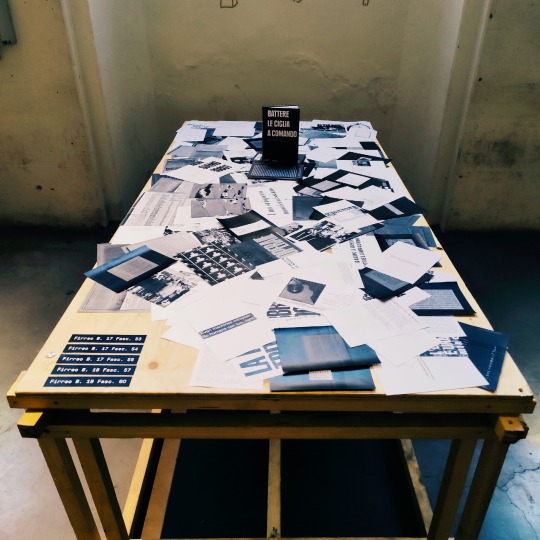



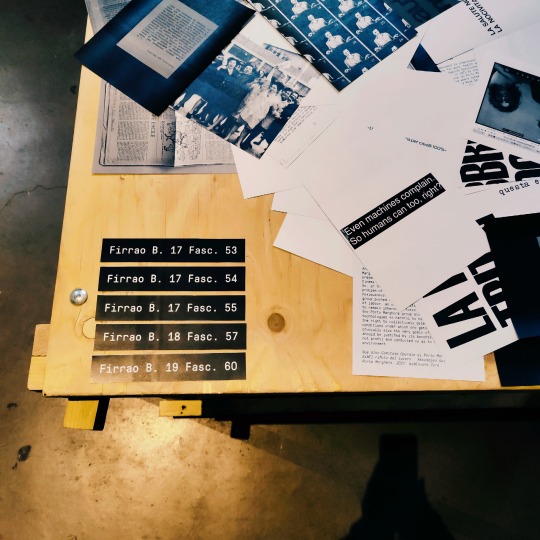
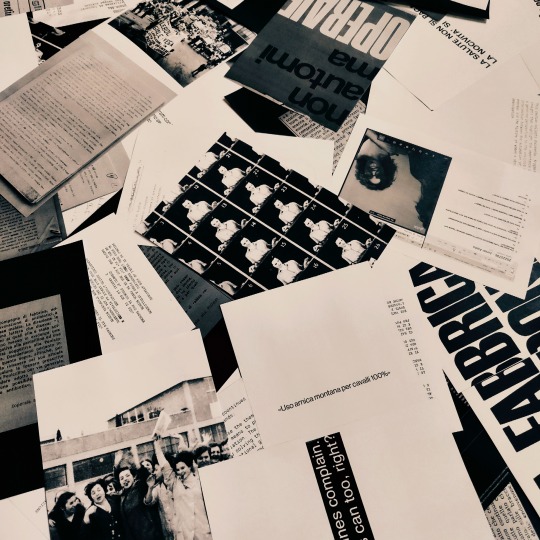
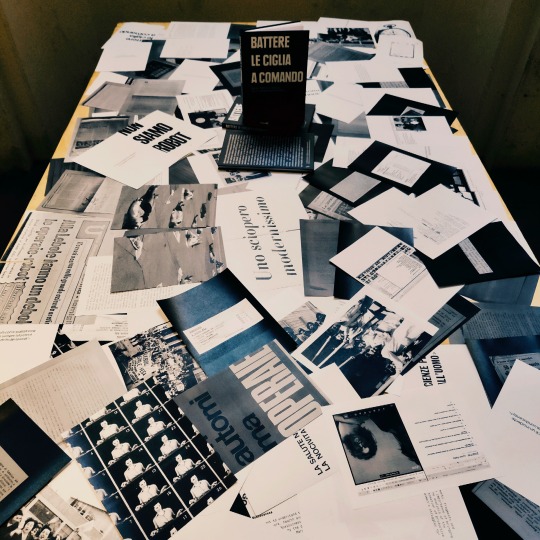


0 notes
Text
Arduino Uno R3 Atmega328
https://sensorembedded.com/Arduino%20Uno%20R3%20Atmega328?search=Arduino%20Uno%20R3%20Atmega328&category_id=0
ARDUINO UNO REV3 with cable is a board to get started with electronics and coding. It is a type of microcontroller board based on the ATmega328P (datasheet). It has 14 digital input/output pins (of which 6 can be used as PWM outputs), 6 analog inputs, a 1
Arduino Uno R3 AtMega328 Dip Atmega16UsbIc is an open source microcontroller board based on ATmega328P chip. It has built-in USB interface and programming headers.
Arduino Uno R3 is a low cost development platform for making interactive objects using sensors and actuators. The Arduino Uno R3 comes in three versions: Atmega328, Atmega328p, and Atmega16u2.
Arduino is an open source hardware and software project started by Massimo Banzi and David Cuartielles in 2005. It was originally designed as a simple prototyping platform with easy-to-learn tools and libraries.

0 notes
Text
Giaco Meet Up 2022 - Torcia Darkfade
Giaco Meet Up 2022 e il Segreto di Giaco! Leggete l'Articolo e guardate il Video YouTube pazzesco in anteprima! Torcia Darkfade e tanti segreti!
Come avrete intuito dal Titolo ho avuto la fortuna di poter partecipare al Giaco Meet Up 2022 ed assistere al lancio su kikstarter e alla presentazione della nuovissima Torcia Darkfade.
Se foste interessati ad altri articoli simili potete sfogliare la Home Page del mio Blog.
Guarda il Video su YouTube ed Iscriviti al Canale
Giaco Meet Up 2022 – Cosa è stato presentato
Durante il Giaco Meet Up…

View On WordPress
#Alessandro Morolla#campagna kickstarter#eventi nerd#giaco#Giaco Meet Up#Giaco Meet Up 2022#Giaco mi ha confidato un segreto#giaco whatever#Giacomo Di Muro#ho trovato OTTO Climan#la nuova startup di giaco#lo studio di Giaco#massimo banzi arduino#Morolla droni#Mr Nobody#MRNBD#MRNBDY#nuove startup#nuove tecnolgie#otto climan#overVolt#startup italiane di successo#torcia darkfade#video con i droni
0 notes
Text
The Good List 56 | Massimo Banzi – 5 progetti open per migliorare il mondo
The Good List 56 | Massimo Banzi – 5 progetti open per migliorare il mondo
Un viaggio alla scoperta di @arduino e di tutte le sue fantastiche applicazioni passando per #Tesla e #Bitcoin
#podcast #arduino #massimobanzi #thegoodlist #tech #nerd #geek
In questa puntata di The Good List intervisto Massimo Banzi – cofondatore del progetto Arduino, una delle più straordinarie innovazioni tecnologiche mai nate in Italia – che ci illustra i 5 progetti open per migliorare il mondoBuon ascolto!

View On WordPress
0 notes
Text
What is Arduino?
Today, the world is developing so fast. But the question is, are we?
Today’s stunning technologies are used by us all the day, all the time. Sometimes, we are ourselves fascinated by what we are able to do by just the click of a button. But, what if, we could make all of that, ourselves?
INTRODUCTION
So, the question arises, how can I make fascinating technologies?
The answer is simple: Learning electronics.
And, how to start with it?
The answer is: ARDUINO
All those people who are interested in robotics or hardware engineering might be familiar with Arduino, unless you haven’t made anything from it yet. Arduino is a open-source (open to public) electronic platform based on easy-to-use hardware and software. In other words (for a simpler definition), Arduino refers to an open-source electronics board and the software used to program it. Arduino is a fantastic way for anyone to learn about robotics, hardware engineering and programming. Over the years Arduino has been the brain of thousands of projects, from everyday objects to complex scientific instruments. Arduino boards are able to read inputs — light on a sensor, a finger on a button, or a Twitter message — and turn it into an output — activating a motor, turning on an LED or publishing something online.

Excited to learn it? Here we go!
HISTORY
The Arduino project was started at the Interaction Design Institute Ivrea (IDII) in Ivrea, Italy. The project goal was to create simple, low cost tools for creating digital projects. At that time, the students used a BASIC Stamp microcontroller at a cost of $50, a considerable expense for many students. In 2003 Hernando Barragán created the development platform Wiring as a Master’s thesis project at IDII, under the supervision of Massimo Banzi and Casey Reas. Wiring was important for Arduino since it is based on wiring in both software and programming language. In 2005, Massimo Banzi, with David Mellis, another IDII student, and David Cuartielles, extended Wiring by adding support for the cheaper ATmega8 microcontroller. The new project, forked from Wiring, was called Arduino.

Massimo Banzi
“Hardware becomes a piece of culture that anyone can build upon, like a poem or a song.”
-Massimo Banzi
WHY ARDUINO?
We know what is Arduino, but why should we choose it. There are dozens of other options out there, so why Arduino:
Arduino is an open-source electronic platform. This means that, not only can the public openly use the software and hardware, it can also constantly update and modify the hardware and software, proving Arduino to be diverse collection of boards. As a matter of fact, huge amounts of software libraries have been made by people at various communities to make the Arduino capable of working and behaving much better with more and more electronic components which are coming up.
Apart from that, Arduino is also one of the most cloned microcontroller boards out their. This means that Arduino is unexpectedly cheap. Moreover, Arduino gives a lot of options to choose from while building your project. It has several boards, some small, some large, each having their own features.
Not only that, the Arduino IDE (Integrated Development Environment) is an all-in-one software IDE, which allows us to program in the same language, for almost every Arduino board out there! This helps a lot as we do not have to download a different IDE each time we buy a different Arduino board!
Since Arduino is an open-source electronic platform, A worldwide community of makers — students, hobbyists, artists, programmers, and professionals — has gathered around this open-source platform, their contributions have added up to an incredible amount of accessible knowledge that can be of great help to novices and experts alike. :)
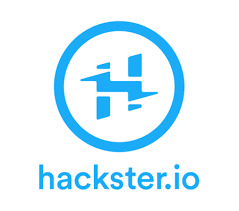
“A child educated only in school is an uneducated child”
— Unknown
HARDWARE
Arduino is open-source hardware. This means layout and production files for some versions of the hardware are also available. Although hardware and software designs for the arduino boards are freely available under the copyleft license, the developers have requested the name “Arduino” to be exclusive to the official product and not be used for derived works without permission. Most Arduino boards consist of an Atmel 8-bit AVR microcontroller (ATmega8, ATmega168, ATmega328, ATmega1280, or ATmega2560) with varying amounts of flash memory, pins, and features. The most famous and common boards include Arduino UNO, Arduino Mega and Arduino Nano. The boards use single or double-row pins or female headers that facilitate connections for programming and incorporation into other circuits. This allows for the connection of wires with male heads and also the connections for shields. Shields here refer to special arduino boards that can be attached over other boards, so as to increase their functionality. Some arduino boards also include ethernet connections, while some are as small as your thumb! Special arduino boards like the Arduino Lily can also be stitched upon clothes, to make wearable devices.

SOFTWARE
Any hardware is useless without a software. We need someone to explain the boards what we need them to do. For this, we have to speak the board’s language. This language is known as machine code and it exists as a series of 1’s and 0’s inside the memory of the board or the computer. Although machine code might be great for computers, it is extremely difficult for humans to understand. Early computers in the 1940’s and 1950’s had what was known as an Assembler. The job of this assembler was to translate assembly language into machine code. Users could write instructions for the computer known as a program with numbers and things that almost looked like words. While it was still difficult to understand, the language was also unique to each type of computer. It was better than writing a machine code but having to write assembly and learn a new set of instruction for each new computer was quite burdensome. So, people began to create high-level programming languages in the 1950’s, such as COBOL, Lisp and Fortran. These languages did not talk in the native language of the computers, but relied on a compiler to translate the high-level language into something the computer can understand. A compiler is simply a program that does the above mentioned work. When you write a program in Arduino, you write in the combination of C and C++ which is a high-level programming language used to construct instructions for Arduino. Arduino has a special software known as the Arduino IDE (short for, Integrated Development Environment) which provides us an environment to write our code into and upload it to the Arduino board.
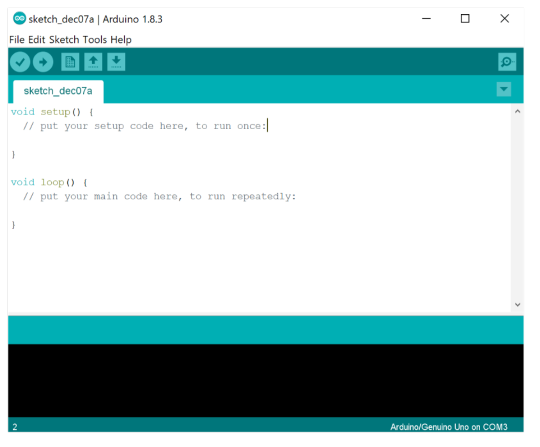
That was all about Arduino, and believe me, this was just an introduction. Further, we will be diving deeper into this marvelous world of electronics, made up of wires and pcb’s!
Do not forget to follow and share with your friends and colleagues. Stay tuned for further updates!
Till then,
Keep innovating!!
3 notes
·
View notes
Photo

Make:cast – To Maker Faire Rome with Love Italians have a love of innovation and design and it shows at Maker Faire Rome. In this episode of Make:Cast, I look back at Maker Faire Rome in October 2019 during a pre-Covid time when live events could happen. I was guided through Maker Faire Rome by Alessandro Ranellucci, the curator of Maker Faire Rome, along with Massimo Banzi, co-founder of Arduino. Maker Faire Rome 2020 is happening as a virtual event this weekend. Read more on MAKE The post Make:cast – To Maker Faire Rome with Love appeared first on Make: DIY Projects and Ideas for Makers. https://buff.ly/381Rz0l
2 notes
·
View notes
Text
Arduino joins the Open Source Security Foundation

As an open-source project, Arduino has always considered security a top priority: making tools and products easy to use for our community has consistently been as important as making them secure.
Today, we are excited to announce that Arduino has joined the Open Source Security Foundation (OpenSFF), the collaborative cross-industry effort to secure the open-source ecosystem.
Hosted at the Linux Foundation, the OpenSFF brings together the efforts of the Core Infrastructure Initiative (CII) and GitHub’s Open Source Security Coalition and is committed to working both upstream and with existing communities to advance the security of open-source software. The foundation will initially include technical initiatives and working groups that will address vulnerability disclosures, security tooling, security best practices, and the identification of security threats to the open-source project.
Arduino is proud to become a member of the OpenSFF alongside GitHub, Google, IBM, Facebook, Red Hat, Facebook, Huawei Technologies, and Samsung. Arduino’s membership to the OpenSFF is also part of the Arduino Donation Program, our philanthropic initiative to fund projects and institutions that can make the difference for the worldwide open-source community.
“Our aim is to make complex technologies simple to use for everyday people and security out of the box is part of the user experience we strive for. We believe that working with skilled security experts and industries across the globe is crucial in identifying security weaknesses and vulnerabilities, “said Arduino co-founder Massimo Banzi. “We are excited to join the Open Source Security Foundation and we look forward to collaborating with other members to improve the security of any open-source ecosystem.”
Arduino joins the Open Source Security Foundation was originally published on PlanetArduino
1 note
·
View note
Text
Atividade 2: Arduino, o documentário.
TAREFA: Avaliar criticamente o vídeo “Arduino, o documentário” (2010).
youtube
O Projeto Arduino consistiu em uma tentativa de popularizar o acesso de estudantes do Instituto Ivrea, Itália, a componentes eletrônicos e estruturas de hardware. Os pesquisadores Massimo Banzi, David Cuartielles, Tom Igoe, Gianluca Martino e David Mellis buscaram desenvolver, por volta de 2005 e com base em projetos anteriores, uma estrutura que fosse mais moderna, mais didática e que não custasse tanto quanto as similares disponíveis no mercado e, além disso, que também pudesse ser programada sem amarras a licenças de proprietários de softwares e fabricantes de hardware, já que estes eram os principais empecilhos ao acesso dos estudantes.

Por causa dos rumores de fechamento da escola por conta da retirada do patrocínio, os pesquisadores decidiram fazer todo desenvolvimento do Projeto de forma open source e engajar mais pessoas, de forma voluntária. As pessoas foram se engajando conforme suas habilidades. Iniciou-se com o Massimo Banzi e seu aluno colombiano David Cuartielles que desenvolveu uma plataforma de hardware chamada Wiring. Utilizando como base a linguagem Processing, software livre, o estudante David Mellis entrou para o time e contribuiu com o software, sob orientação de Tom Igoe. Então, Gianluca Martino veio para possibilitar a fabricação própria das placas, após fazer um redesign na placa aprovada. Portanto, a equipe formou-se conforme a habilidade necessária em cada etapa para o prosseguimento do Projeto.

Daí, o Projeto decolou. As primeiras unidades foram encomendadas e rapidamente a demanda aumentou por conta das oficinas promovidas. Podia-se fazer muitas coisas com um custo bem menor. O sistema permitia acesso e aprendizado de como as coisas funcionam em um “sistema hardware + software” com um custo bem reduzido.
Foi uma revolução na ideia de aplicação de ferramentas livres de software aliada ao hardware livre, conceito novo na época. As pessoas passaram a ter acesso às ferramentas sem terem que pagar por licenças ou patentes. O entendimento do controle de itens eletrônicos através de software ganhou força exponencial.

O Projeto alavancou a questão do hardware open source para fins educacionais e de produção de coisas mais simples, cotidianas, porém importantes, sem muito custo e de forma legal, sem transtornos ou problemas com licenças ou leis. Todas as ideias produzidas com base no projeto poderiam ser utilizadas por qualquer pessoa, melhoradas e aprimoradas, e novamente repassadas.
A criação de comunidades colaborativas com o Projeto deu fôlego e prosperidade à ideia inicial. Hoje, existem vários colaboradores e desenvolvedores trabalhando na melhoria e ampliação das possibilidades de uso e aplicação do Arduino nas mais diversas áreas e podemos até chamá-lo de pai da internet das coisas. Temos aplicações do arduino como controladores de aplicações com sensores, luzes, sons, motores e diversos tipos de automação.

Portanto, o que se vê é que o Projeto Arduino é um dos principais casos históricos de sucesso na busca pela popularização do acesso ao conhecimento do funcionamento de hardware e sua interação com o software. A libertação das amarras das licenças e patentes de softwares e, especialmente, de hardwares é a principal contribuição: revolucionário! A facilidade de uso, o tamanho, a versatilidade e o valor financeiro acessível também são fatores contribuintes para o estrondoso sucesso do Projeto.

Obrigado !
1 note
·
View note
Photo

A fine book for young and young-at-heart experimenters who want to learn basic circuitry and basic physical computing
This book does an excellent job of showing and explaining how basic circuits are created and how the components of Ohm's Law--voltage, current and resistance--work together and can be manipulated using resistors, potentiometers, LEDs, and switches. The book also shows how to use a popular and inexpensive Arduino Uno computer and an experimenter's breadboard to create "physical computing" circuits that can be controlled with simple programs, or "sketches" as they are known in Arduino world. I am not fond, however, of the book's title, "Learn Electronics with Arduino," unless there is a plan to continue with a series of books that teach other aspects of basic electronics, including capacitance and inductance, with an Arduino's help. "Electronics" itself consists of much more than Ohm's Law and open or closed circuits. Still, this is a fine book for young and young-at-heart experimenters who want to learn basic circuitry and basic physical computing, such as controlling servos or putting light-sensitive photoresistors or passive infrared motion sensors to practical use.
Go to Amazon
Great all-in-one introduction to DC circuits, digital devices, and coding
This beginnner's guide to the popular Arduino microcontroller family by author-illustrator Jody Culkin and interactive artist Eric Hagan nicely fills a niche in the existing literature between Massimo Banzi and Michael Shiloh's classic "Getting Started with Arduino" and the more advanced books by folks like Simon Monk and Steve Gold. It's a particularly good choice for someone with no electronics background who may need a bit more hand-holding than Banzi and Shiloh can provide in their little book. Concepts are explained in plain language with just the right technical depth to impart understanding and maintain interest without getting bogged down, and the skills developed in the hands-on projects build smoothly on one another to create a compact but robust curriculum in basic electronics.
Go to Amazon
An excellent introduction to microcontroller electronics
This book is great. It explains the basics of electronics needed to work with microcontrollers like Arduino in clear, succinct language, drawings, and diagrams. Their highly visual style is very good for beginners. The language is accessible to middle school students, yet helpful for adults who are new to the subject as well. I'll use this book in my classes for sure.
Go to Amazon
it's easy to start learning electronics
With Arduino, and this book, it's easy to start learning electronics. The book contains very good explanations of electronics basics, features nice projects to build, and is beautifully illustrated.
Go to Amazon
1 note
·
View note
Photo

Mouser Electronics and Grant Imahara Explore Prototype Design with Arduino in Latest “Engineering Big Ideas” Series Video via Yahoo Finance
In the second video of the Engineering Big Ideas series, Mouser and Imahara take viewers along to Milan, Italy, for a visit to Arduino®, one of the world’s leading open-source hardware and software ecosystems. Imahara sits down with Arduino co-founder and CTO Massimo Banzi to examine the prototyping tools designers and developers use to understand and articulate the capabilities and limits of an idea. The pair also explores how the open source movement contributes to broadening access to innovation. The Engineering Big Ideas series is sponsored by Mouser’s valued suppliers Analog Devices, Intel®, Microchip Technology and Molex.
0 notes
Text
A chat with the creators of Arduino
On this week’s Technotopia I talked to Massimo Banzi and Fabio Violante, the co-creators of Arduino. This pair of Italian artists saw their little single-board computers as a gateway to high-tech art but they’ve essentially created a world in which anyone – from an 11-year-old hacker to a huge corporation – can make amazing hardware in a few hours. The pair recently… Read More http://j.mp/2goWqyD
2 notes
·
View notes
Text
A chat with the creators of Arduino
A chat with the creators of Arduino
On this week’s Technotopia I talked to Massimo Banzi and Fabio Violante, the co-creators of Arduino. This pair of Italian artists saw their little single-board computers as a gateway to high-tech art but they’ve essentially created a world in which anyone – from an 11-year-old hacker to a huge corporation – can make amazing hardware in a few hours.
The pair recently… Read More
Gadgets –…
View On WordPress
1 note
·
View note
Photo


A chat with the creators of Arduino
On this week’s Technotopia I talked to Massimo Banzi and Fabio Violante, the co-creators of Arduino. This pair of Italian artists saw their little single-board computers as a gateway to high-tech art but they’ve essentially created a world in which anyone – from an 11-year-old hacker to a huge corporation – can make amazing hardware in a few hours.
The pair recently… Read More
https://techcrunch.com/2017/10/09/a-chat-with-the-creators-of-arduino/?ncid=rss
0 notes